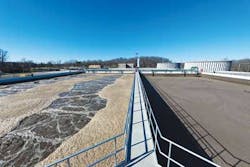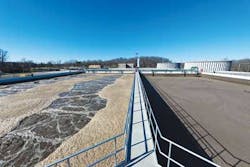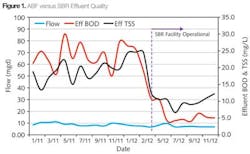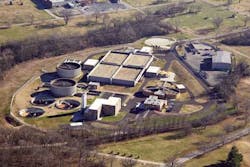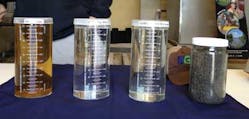By Ken Baker, Kim Hargett and Mike Gardner
Bowling Green, the third largest city in the Commonwealth of Kentucky, supports a population approaching 60,000. Water and wastewater services in Bowling Green are provided by Bowling Green Municipal Utilities (BGMU) which owns and operates a newly-constructed 12 mgd Sequencing Batch Reactor (SBR) wastewater treatment plant.
The new SBR facility commenced operation in April 2012, replacing an antiquated 10.6 mgd activated biofilter (ABF) plant on the same site. Growth, aging infrastructure and more stringent effluent requirements were the primary drivers for the WWTP upgrade. The SBR process was selected to address site constraints and enable biological nutrient removal (BNR) to reduce nitrogen and phosphorus concentrations in the effluent. The waste activated sludge (WAS) generated by the new SBR process required the addition of a long-term and sustainable biosolids management practice. For this project, the team selected mechanical dewatering and indirect thermal drying producing a Class A product.
Given the significant scope and monetary investment associated with the WWTP renovation and expansion project, BGMU staff committed extensive internal resources to formulate a cost-effective plan for its completion. The first step involved procuring an engineering firm that had both engineering and operational experience to manage the project and partner with BGMU for its successful completion. Nashville-based Gresham, Smith and Partners possessed these qualifications and was commissioned by BGMU to lead the design and engineering processes required to evaluate treatment alternatives and present recommended solutions to meet more stringent effluent requirements.
The project team was comprised of project managers, engineers, operational staff, and maintenance staff representing Gresham, Smith and Partners and BGMU. This approach was used to solicit critical input from BGMU's operation and maintenance staff during the design phase and promote ownership in the project.
The project team was challenged to develop recommendations that met the criteria established by the basis of design. These criteria included use of energy-efficient equipment and existing tankage where practical; simplicity and reliability of operation and maintenance; 20-year life cycle costs; a sustainable treatment process that could provide Biological Nutrient Removal (BNR); using the existing site and avoiding any construction in the flood plain; and minimized disruption of existing plant operations during construction.
The key criterion and critical path for this project was to design and build the treatment plant improvements on the existing 39-acre site, even though approximately 50 percent of the site was situated in a flood plain, and a significant portion of the remaining property was occupied by the existing facility.
The activated sludge process was determined to be the logical choice to provide BNR treatment for phosphorus and nitrogen removal. The project team evaluated an array of activated sludge processes including oxidation ditches, activated sludge with selectors, multi-staged BNR (Bardenpho®, A2O, etc.), and membrane bioreactors (MBR). The wide use of the oxidation ditch made the process an early favorite, primarily for ease of operation. The MBR process was intriguing and could have produced a high quality effluent within a small footprint, but capital and O&M costs drove this technology to the bottom of the ranking. During the evaluation of potential treatment systems, Gresham, Smith and Partners also used the GPS-X™ process simulation model, developed by Hydromantis Environmental Software Solutions, as a tool to help compare the performance of various biological processes and determine if any performance limitations existed.
Size Does Matter
In the end, the constraints of the site drove the decision to select the Sequencing Batch Reactor process for BGMU's wastewater treatment improvements. The small footprint and compactness of using single basins for flow equalization, aerated biological treatment, sedimentation, and anoxic selection fit the criteria established for this project.
Compared to the other activated sludge processes, the SBR's recognized advantages included: 1) significant reduction of the overall footprint of the entire facility; 2) reduction of hydraulic complexities associated with flow distribution to multiple process tanks; 3) elimination of separate return activated sludge pumping or transferring; 4) elimination of additional tankage and concrete for independent processes such as clarification; 5) simplified construction sequencing minimizing interruptions to existing plant operations; 6) ease of potential expansions; and, 7) programmable logic controls (PLC) provided by the SBR manufacturer, offering detailed operational control of process systems that freed operators to work the system in lieu of performing time consuming tasks such as effluent weir cleaning.
Additionally, the results from the process simulation modeling showed that the SBR could provide biological phosphorus removal and nitrification as needed to meet effluent requirements further supporting the decision to select the SBR process.
Sequencing Batch Reactor
Following an evaluation of equipment provided by various SBR manufacturers, the project team elected to design the SBR using equipment provided by Jet Tech, a Siemens Water Technologies' company. The SBR design was based on a projected average daily flow of 15 mgd and an average biochemical oxygen demand (BOD) loading of approximately 13,000 lbs. per day. These basic design conditions would require the construction of up to six bioreactors. The economic downturn that hit the country during this project slowed proposed growth in Bowling Green and Warren County, resulting in a decision to design the facility for projected flows and loadings but only build four bioreactors to meet short-term flows and loads with plans to construct the additional basins as needed in the future.
Each bioreactor has the volumetric capacity of 3.27 million gallons (168 ft x 100 ft x 26 ft) for a total hydraulic volume of 13.1 MG — making the BGMU facility one of the largest municipal SBRs in the U.S. Jet aeration technology was selected to provide aeration and mixing of the suspended biomass. Winter conditions dictated the majority of design conditions used for this facility. Each bioreactor requires approximately 38,000 lbs. per day of oxygen, which is supplied by HST 9000 turbocompressor blowers provided by Sulzer/ABS. Each reactor basin is designed for 4.0 batch operating cycles per day.
Start-up and commissioning of the newly-constructed SBR began in late February 2012. Because cold temperatures still prevailed in Kentucky, seed sludge from nearby activated sludge plants was used to facilitate hearty acclimation of the biomass. By April 2012, all the wastewater flow in Bowling Green was being treated by the new SBR plant.
Immediate improvement in effluent quality was recognized once the SBR biomass acclimated in the basins. Operational data from January 2011 through March 2012 depicted the monthly average effluent BOD, and TSS from the ABF facility was 23.4 and 19.7 mg/L, respectively. From April 2012 through December 2012 when the SBR was fully operational, the monthly average effluent BOD and TSS was 6.1 and 10.1 mg/L, respectively.
Additional verification of improved effluent quality was also recognized in reduction of ammonia and phosphorus concentrations. It is obvious by reviewing the data that the biomass is supporting a healthy population of nitrifying bacteria and achieving biological removal of phosphorus. The numbers tell the story as the monthly average effluent ammonia concentration from January 2011 through May 2012 was 6.7 mg/L and improved to 0.8 mg/L from June 2012 through December 2012, a reduction of almost 90 percent.
About the Authors:Ken Baker is senior vice president in the Water Resources Division of Gresham, Smith and Partners in Nashville, TN. Kim Hargett, P.E., is president at Tegrah Engineering, P.C., and was formerly senior project manager for the BGMU project at Gresham, Smith and Partners. Mike Gardner, P.E., is Systems Manager, Water/Wastewater Division of Bowling Green Municipal Utilities in Bowling Green, KY.
BGMU's Cutting-Edge Biosolids Handling and Disposal Process
Another significant component of the wastewater treatment plant upgrade and expansion at Bowling Green Municipal Utilities was the design of a sustainable, cost-effective solution for biosolids handling and disposal.
BGMU, like other municipal utilities, was dewatering waste solids generated at their wastewater treatment plant and hauling the dewatered cake to a landfill for disposal. Escalating costs for transportation and landfill tipping fees — combined with the lack of assurances that the landfill would continue to accept the waste on a long-term basis — encouraged the evaluation of alternative solutions for residuals management. Gresham, Smith and Partners implemented an evaluation process to consider alternative means and methods to reduce residuals management costs based on a 20-year life-cycle-cost analysis, as well as to reduce biosolids volume and produce a sustainable Class A product.
The comprehensive evaluation process yielded an indirect thermal dryer manufactured by Therma-Flite as the best overall solution for BGMU. The IC 10000 Therma-Flite Holo-Scru® is an automated, indirectly heated, continuous-flow biosolids dryer system. Its supporting design required ingenuity, as the GS&P team had to convert three existing blended sludge tanks into aerated holding tanks for waste-activated sludge (WAS). Coarse air diffusers, high-efficiency turbo-compressor blowers and floating decanters were installed in these tanks.
The WAS is thickened using a decanting process and pumped to one of three high-speed centrifuges for dewatering. The dewatered cake is conveyed using shaftless augers to one of two wet-cake storage bins with live bottoms that feed progressive cavity pumps. The pumps can either pump out to trucks for hauling to the landfill or directly into the Therma-Flite indirect thermal dryer. A static biofilter is used for off-gas odor control.
At the end of the process, the dried, Class-A biosolids are pneumatically conveyed to one of two dry-product storage silos where they can be purchased by area farmers as a soil amendment and fertilizer supplement. The product is currently marketed as "BGreen," and it helps farmers save up to 75 percent on fertilizer costs.
The system meets the basic criteria of reducing the volume of biosolids by a ratio of up to five times and producing a Class A product at a cost less than landfilling on a cost-per-dry-ton basis. As for the BGreen product, there is some anticipation that BGMU may encounter a unique but acceptable issue of demand exceeding supply.
More WaterWorld Current Issue Articles
More WaterWorld Archives Issue Articles
